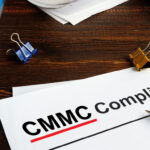What Is CMMC?
The Cybersecurity Maturity Model Certification (CMMC) is a framework developed by the U.S. Department of Defense (DoD) to ensure that contractors and subcontractors handling sensitive government data meet rigorous cybersecurity standards. It applies to organizations that process, store, or transmit Controlled Unclassified Information (CUI) or Federal Contract Information (FCI)1.
For small and mid-sized businesses (SMBs) working with the DoD, understanding and complying with CMMC is no longer optional, it’s essential for contract eligibility.
CMMC 2.0, the current version, simplifies the original model by reducing the number of levels from five to three. This shift is designed to make compliance more accessible while maintaining strong security expectations.
- Level 1: Basic safeguarding of FCI (self-assessment)
- Level 2: Protection of CUI (self-assessment or third-party assessment depending on requirements)
- Level 3: Advanced protection for highly sensitive DoD CUI against persistent threats (DoD-led assessment)
These levels align with NIST SP 800-171 Revision 2 and NIST SP 800-1722, reinforcing best practices for data protection.
Why SMBs Should Pay Attention
While CMMC is often associated with large defense contractors, SMBs are deeply embedded in the Defense Industrial Base (DIB). Whether you’re a subcontractor, IT vendor, or cloud service provider, CMMC may apply to you.
Key considerations for SMBs:
- CMMC requirements will be embedded in DoD contracts, and noncompliance means disqualification.
- Even Level 1 requires formal documentation and annual self-assessments.
- Level 2 introduces third-party assessments for contractors handling prioritized CUI.
The DoD has acknowledged the burden on SMBs and adjusted CMMC 2.0 accordingly, but the core requirements remain.
For many SMBs, the most relevant level is Level 2, which applies to organizations handling CUI, but not highly sensitive DoD CUI. While some Level 2 contractors may be eligible for self-assessment, others that handle prioritized CUI will require third-party assessment depending on contract terms.
CMMC Timeline: What SMBs Need to Know
The DoD is implementing CMMC in phases. While the exact contract inclusion dates will vary, the DoD has confirmed that Level 2 self-assessments went into operation in the Supplier Performance Risk System (SPRS) starting February 28, 2025. Full rollout is expected to span several years, culminating in universal contract enforcement by 2027–20283.
Here are some key milestones to consider, and what they could mean for your business operations and contract eligibility.
Phase 1: Q1 2025
- Requirements summary: Level 1 and Level 2 self-assessments begin. Scores must be submitted to SPRS.
- Impact on SMBs: Low-cost entry point for basic compliance. Ideal time to build your System Security Plan (SSP) and Plan of Action and Milestones (POA&M).
Phase 2: 2025-2026
- Requirements summary: Level 2 third-party assessments required for contracts involving prioritized CUI.
- Impact on SMBs: SMBs must engage a Certified Third-Party Assessor Organization (C3PAO) and budget for assessments. Early action avoids bottlenecks.
Phase 3: 2026-2027
- Requirements summary: Level 3 DoD-led assessments for high-security contracts handling highly sensitive DoD CUI.
- Impact on SMBs: Rare for SMBs, but prime contractors may require flow-down compliance.
Phase 4: 2027-2028
- Requirements summary: Full implementation across all DoD contracts.
- Impact on SMBs: No certification = no contract. Compliance becomes a go/no-go factor.
What Businesses Should Do Now
Even if you’re a subcontractor or a small services provider, CMMC could apply to you. Here’s how to get ahead:
1. Determine Your Data Type
- If you handle Federal Contract Information (FCI) → You’re likely Level 1.
- If you handle Controlled Unclassified Information (CUI) → You’re Level 2.
- If you handle highly sensitive DoD CUI → You’re Level 3.
- Unsure? Review your contracts or ask your prime contractor.
2. Run a Self-Assessment or Work with an Experienced GRC Partner
- Use NIST SP 800-171 Revision 22 to evaluate your cybersecurity posture.
- Submit your score to SPRS4 with executive affirmation.
3. Build Your SSP and POA&M
- Your System Security Plan (SSP) documents your current controls.
- Your Plan of Action & Milestones (POA&M) outlines gaps and remediation timelines.
- These are required—even for self-assessments.
4. Talk to Your Prime Contractor
- If you’re a subcontractor, ask your prime what CMMC level they expect of you.
- Align your efforts early to remain a preferred partner.
The Bottom Line
CMMC is not just a compliance exercise, it’s a strategic investment in cybersecurity resilience, and a necessary component to stay in the DoD supply chain.
Understanding where your organization falls within the CMMC framework—and preparing accordingly—is key to maintaining DoD and prime contractor relationships and avoiding costly disruptions.
Don’t wait for the deadline to take action. Contact us today to assess your current posture and build a roadmap for full CMMC compliance.
Additional Resources:
1 https://dodcio.defense.gov/CMMC/Resources-Documentation/
2 https://csrc.nist.gov/pubs/sp/800/171/r2/upd1/final
3 https://dodcio.defense.gov/CMMC/About/
4 https://www.sprs.csd.disa.mil/









